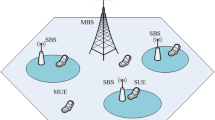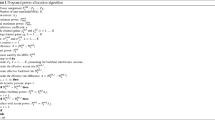Abstract
Fifth generation (5G) mobile communication networks have the ability to deal with the growing need for increased data rates, decreased network latencies, low power consumption, seamless coverage, and massive connectivity while sustaining the high Quality of Service (QoS) at the subscriber’s end. The key drivers of beyond 5G (B5G) are anticipated to be the convergence of all the features of 5G and B5G becomes more heterogeneous with the different small cell access points and massive multiple-input multiple-output (massive MIMO). In this work, the macro base station enabled with massive MIMO technology and the small cell access points possessing the full-duplex communication ability in a heterogeneous network (HetNet) is investigated. The prime objective is to optimize the power utilization by employing scaled beamforming and power allocation techniques with reduced complexity while sustaining the QoS in a full-duplex massive MIMO enabled HetNet with small cells. The joint power optimization and scaled beamforming algorithm is used to maximize the sum rates with reduced power consumption when compared to multi-flow zero-forcing (MZF) beamforming. The complexity analysis is also carried out by optimizing the number of transmission antennas and users.








Similar content being viewed by others
Change history
24 November 2020
A Correction to this paper has been published: <ExternalRef><RefSource>https://doi.org/10.1007/s12083-020-01040-y</RefSource><RefTarget Address="10.1007/s12083-020-01040-y" TargetType="DOI"/></ExternalRef>
References
Cisco VNI (2018) Cisco visual networking index: forecast and trends, 2017–2022. White Paper 1
Nguyen LD, Tuan HD, Duong TQ, Dobre OA, Poor HV (2018) Downlink beamforming for energy-efficient heterogeneous networks with massive MIMO and small cells. IEEE Trans Wirel Commun 17(5):3386–3400
Lu L, Li GY, Swindlehurst AL, Ashikhmin A, Zhang R (2014) An overview of massive MIMO: benefits and challenges. IEEE J Select Topics Signal Process 8(5):742–758
Björnson E, Larsson EG, Marzetta TL (2016) Massive MIMO: ten myths and one critical question. IEEE Commun Mag 54(2):114–123
Zhang J, Björnson E, Matthaiou M, Ng DWK, Yang H, Love DJ (2020) Prospective multiple antenna technologies for beyond 5G. arXiv preprint arXiv:1910.00092 v3
Van Chien T, Canh TN, Björnson E, Larsson EG (2020) Power control in cellular massive MIMO with varying user activity: a deep learning solution. IEEE Trans Wirel Commun:1. https://doi.org/10.1109/TWC.2020.2996368
Zeydan E, Dedeoglu O, Turk Y (2020) Experimental evaluations of TDD-based massive MIMO deployment for Mobile network operators. IEEE Access 8:33202–33214
Hoydis J, Ten Brink S, Debbah M (2013) Massive MIMO in the UL/DL of cellular networks: how many antennas do we need? IEEE J Select Areas Commun 31(2):160–171
Sheikhi A, Razavizadeh SM, Lee I (2020) A comparison of TDD and FDD massive MIMO systems against smart jamming. IEEE Access 8:72068–72077
Li B, Zhu D, Liang P (2015) Small cell in-band wireless backhaul in massive MIMO systems: a cooperation of next-generation techniques. IEEE Trans Wirel Commun 14(12):7057–7069
Tabassum H, Sakr AH, Hossain E (2016) Analysis of massive MIMO-enabled downlink wireless backhauling for full-duplex small cells. IEEE Trans Commun 64(6):2354–2369
Ragunathan S, Perumal D (2020) Enhancement of energy efficiency in massive MIMO network using superimposed pilots. J Ambient Intell Humanized Comput:1–8
Chen X, Ng DWK, Yu W, Larsson EG, Al-Dhahir N, Schober R (2020) Massive access for 5G and beyond. arXiv preprint arXiv:2002.03491
Matthaiou M, Yurduseven O, Ngo HQ, Morales-Jimenez D, Cotton SL, Fusco VF (2020) The road to 6G: ten physical layer challenges for communications engineers. arXiv preprint arXiv:2004.07130
Xie Y, Li B, Zuo X, Yan Z, Yang M (2018) Performance analysis for 5G beamforming heterogeneous networks. Wirel Netw:1–15
Hoydis J, Hosseini K, Ten Brink S, Debbah M (2013) Making smart use of excess antennas: massive MIMO, small cells, and TDD. Bell Labs Technical J 18(2):5–21
Pitaval RA, Tirkkonen O, Wichman R, Pajukoski K, Lahetkangas E, Tiirola E (2015) Full-duplex self-backhauling for small-cell 5G networks. IEEE Wirel Commun 22(5):83–89
Lagunas E, Lei L, Maleki S, Chatzinotas S, Ottersten B (2017) Power allocation for in-band full-duplex self-backhauling. In 2017 40th International Conference on Telecommunications and Signal Processing (TSP). IEEE, pp 136-139
Chen L, Yu FR, Ji H, Leung VC, Li X, Rong B (2016). A full-duplex self-backhaul scheme for small cell networks with massive MIMO. In 2016 IEEE International Conference on Communications (ICC). IEEE, pp 1-6
Mao T, Feng G, Liang L, Qin S, Wu B (2015) Distributed energy-efficient power control for macro–femto networks. IEEE Trans Veh Technol 65(2):718–731
Mili MR, Hamdi KA, Marvasti F, Bennis M (2015) Joint optimization for optimal power allocation in OFDMA femtocell networks. IEEE Commun Lett 20(1):133–136
Gao H, Su Y, Zhang S, Diao M (2019) Antenna selection and power allocation design for 5G massive MIMO uplink networks. China Commun 16(4):1–15
Ghazanfari A, Cheng HV, Björnson E, Larsson EG (2020) Enhanced fairness and scalability of power control schemes in multi-cell massive MIMO. IEEE Trans Commun 68(5):2878–2890
Tripathi SC, Trivedi A, Rajoria S (2018) Power optimization of cell free massive MIMO with zero-forcing beamforming technique. In 2018 Conference on Information and Communication Technology (CICT). IEEE, pp 1-4
Zhang J, Jiang Y, Li P, Zheng F, You X (2016) Energy efficient power allocation in massive MIMO systems based on standard interference function. In 2016 IEEE 83rd Vehicular Technology Conference (VTC Spring). IEEE, pp 1-6
Duarte M, Sabharwal A, Aggarwal V, Jana R, Ramakrishnan KK, Rice CW, Shankaranarayanan NK (2013) Design and characterization of a full-duplex multiantenna system for WiFi networks. IEEE Trans Veh Technol 63(3):1160–1177
Björnson E, Sanguinetti L, Hoydis J, Debbah M (2015) Optimal design of energy-efficient multi-user MIMO systems: is massive MIMO the answer? IEEE Trans Wirel Commun 14(6):3059–3075
Björnson E, Kountouris M, Debbah M (2013) Massive MIMO and small cells: improving energy efficiency by optimal soft-cell coordination. In ICT 2013. IEEE, pp 1-5
Telatar E (1999) Capacity of multi-antenna Gaussian channels. Eur Trans Telecommun 10(6):585–595
Sofi IB, Gupta A, Jha RK (2019) Power and energy optimization with reduced complexity in different deployment scenarios of massive MIMO network. Int J Commun Syst 32(6):e3907
Kela P, Costa M, Turkka J, Leppanen K, Jantti R (2016) Flexible backhauling with massive mimo for ultra-dense networks. IEEE Access 4:9625–9634
Li B, Zhu D, Liang P (2015) Small cell in-band wireless backhaul in massive MIMO systems: a cooperation of next-generation techniques. IEEE Trans Wirel Commun 14(12):7057–7069
Korpi D, Riihonen T, Valkama M (2016) Self-backhauling full-duplex access node with massive antenna arrays: power allocation and achievable sum-rate. In 2016 24th European Signal Processing Conference (EUSIPCO). IEEE pp 1618-1622
Korpi D, Riihonen T, Valkama M (2017) Inband full-duplex radio access system with self-backhauling: transmit power minimization under QoS requirements. In 2017 IEEE International Conference on Acoustics, Speech and Signal Processing (ICASSP). IEEE, pp 6558-6562
CVX Research Inc. (2012) CVX: Matlab software for disciplined convex programming, version 2.0 beta. http://cvxr.com/cvx
Author information
Authors and Affiliations
Corresponding author
Additional information
Publisher’s note
Springer Nature remains neutral with regard to jurisdictional claims in published maps and institutional affiliations.
The original version of this article was revised: There is a mismatch between the equation citations and equation labels.
This article is part of the Topical Collection: Special Issue on P2P Computing for Beyond 5G Network and Internet-of-Everything
Guest Editors: Prakasam P, Ajayan John, Shohel Sayeed
Rights and permissions
About this article
Cite this article
Balachandran, M., Vali Mohamad, N. Joint power optimization and scaled beamforming approach in B5G network based massive MIMO enabled HetNet with full-duplex small cells. Peer-to-Peer Netw. Appl. 14, 333–348 (2021). https://doi.org/10.1007/s12083-020-00998-z
Received:
Accepted:
Published:
Issue Date:
DOI: https://doi.org/10.1007/s12083-020-00998-z




